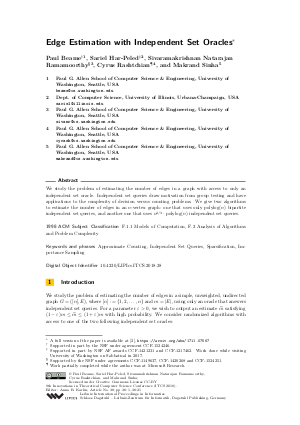Edge Estimation with Independent Set Oracles
Authors Paul Beame, Sariel Har-Peled, Sivaramakrishnan Natarajan Ramamoorthy, Cyrus Rashtchian, Makrand Sinha
-
Part of:
Volume:
9th Innovations in Theoretical Computer Science Conference (ITCS 2018)
Part of: Series: Leibniz International Proceedings in Informatics (LIPIcs)
Part of: Conference: Innovations in Theoretical Computer Science Conference (ITCS) - License:
 Creative Commons Attribution 3.0 Unported license
Creative Commons Attribution 3.0 Unported license
- Publication Date: 2018-01-12
File

PDF
LIPIcs.ITCS.2018.38.pdf
- Filesize: 0.68 MB
- 21 pages
Document Identifiers
Subject Classification
Keywords
- Approximate Counting
- Independent Set Queries
- Sparsification
- Importance Sampling
Metrics
- Access Statistics
-
Total Accesses (updated on a weekly basis)
0Document
0Metadata
Abstract
We study the problem of estimating the number of edges in a graph with access to only an independent set oracle. Independent set queries draw motivation from group testing and have applications to the complexity of decision versus counting problems. We give two algorithms to estimate the number of edges in an n-vertex graph: one that uses only polylog(n) bipartite independent set queries, and another one that uses n^{2/3} polylog(n) independent set queries.
Cite As Get BibTex
Paul Beame, Sariel Har-Peled, Sivaramakrishnan Natarajan Ramamoorthy, Cyrus Rashtchian, and Makrand Sinha. Edge Estimation with Independent Set Oracles. In 9th Innovations in Theoretical Computer Science Conference (ITCS 2018). Leibniz International Proceedings in Informatics (LIPIcs), Volume 94, pp. 38:1-38:21, Schloss Dagstuhl – Leibniz-Zentrum für Informatik (2018)
https://doi.org/10.4230/LIPIcs.ITCS.2018.38
BibTex
@InProceedings{beame_et_al:LIPIcs.ITCS.2018.38,
author = {Beame, Paul and Har-Peled, Sariel and Natarajan Ramamoorthy, Sivaramakrishnan and Rashtchian, Cyrus and Sinha, Makrand},
title = {{Edge Estimation with Independent Set Oracles}},
booktitle = {9th Innovations in Theoretical Computer Science Conference (ITCS 2018)},
pages = {38:1--38:21},
series = {Leibniz International Proceedings in Informatics (LIPIcs)},
ISBN = {978-3-95977-060-6},
ISSN = {1868-8969},
year = {2018},
volume = {94},
editor = {Karlin, Anna R.},
publisher = {Schloss Dagstuhl -- Leibniz-Zentrum f{\"u}r Informatik},
address = {Dagstuhl, Germany},
URL = {https://drops.dagstuhl.de/entities/document/10.4230/LIPIcs.ITCS.2018.38},
URN = {urn:nbn:de:0030-drops-83552},
doi = {10.4230/LIPIcs.ITCS.2018.38},
annote = {Keywords: Approximate Counting, Independent Set Queries, Sparsification, Importance Sampling}
}
Author Details
References
-
B. Aronov and S. Har-Peled. On Approximating the Depth and Related Problems. SIAM J. Comput., 38(3):899-921, 2008.

- Paul Beame, Sariel Har-Peled, Sivaramakrishnan Natarajan Ramamoorthy, Cyrus Rashtchian, and Makrand Sinha. Edge Estimation with Independent Set Oracles. CoRR, abs/1711.07567, 2017. URL: http://arxiv.org/abs/1711.07567.
-
Ido Ben-Eliezer, Tali Kaufman, Michael Krivelevich, and Dana Ron. Comparing the strength of query types in property testing: The case of k-colorability. Computational Complexity, 22(1):89-135, 2013.

-
Sergio Cabello and Miha Jejčič. Shortest paths in intersection graphs of unit disks. Computational Geometry, 48(4):360-367, 2015.

-
Chao L Chen and William H Swallow. Using Group Testing to Estimate a Proportion, and to Test the Binomial Model. Biometrics, pages 1035-1046, 1990.

-
Holger Dell and John Lapinskas. Fine-grained reductions from approximate counting to decision. CoRR, abs/1707.04609, 2017.

-
Robert Dorfman. The Detection of Defective Members of Large Populations. The Annals of Mathematical Statistics, 14(4):436-440, 1943.

-
Devdatt P Dubhashi and Alessandro Panconesi. Concentration of Measure for the Analysis of Randomized Algorithms. Cambridge University Press, 2009.

- T. Eden, D. Ron, and C. Seshadhri. On Approximating the Number of k-cliques in Sublinear Time. ArXiv e-prints, 2017. URL: http://arxiv.org/abs/1707.04858.
-
Talya Eden, Amit Levi, Dana Ron, and C. Seshadhri. Approximately counting triangles in sublinear time. In Venkatesan Guruswami, editor, IEEE 56th Annual Symposium on Foundations of Computer Science, FOCS 2015, Berkeley, CA, USA, 17-20 October, 2015, pages 614-633. IEEE Computer Society, 2015.

-
Talya Eden and Will Rosenbaum. On Sampling Edges Almost Uniformly. arXiv preprint arXiv:1706.09748, 2017.

-
Moein Falahatgar, Ashkan Jafarpour, Alon Orlitsky, Venkatadheeraj Pichapati, and Ananda Theertha Suresh. Estimating the number of defectives with group testing. In ISIT, pages 1376-1380. IEEE, 2016.

-
Uriel Feige. On sums of independent random variables with unbounded variance and estimating the average degree in a graph. SIAM Journal on Computing, 35(4):964-984, 2006.

-
Aleksei V Fishkin. Disk graphs: A short survey. In International Workshop on Approximation and Online Algorithms, pages 260-264. Springer, 2003.

-
Oded Goldreich and Dana Ron. Approximating average parameters of graphs. Random Structures &Algorithms, 32(4):473-493, 2008.

-
Mira Gonen, Dana Ron, and Yuval Shavitt. Counting stars and other small subgraphs in sublinear-time. SIAM J. Discrete Math, 25(3):1365-1411, 2011.

-
Robert J Klein, Caroline Zeiss, Emily Y Chew, Jen-Yue Tsai, Richard S Sackler, Chad Haynes, Alice K Henning, John Paul SanGiovanni, Shrikant M Mane, Susan T Mayne, et al. Complement factor h polymorphism in age-related macular degeneration. Science, 308(5720):385-389, 2005.

-
Krzysztof Onak, Dana Ron, Michal Rosen, and Ronitt Rubinfeld. A near-optimal sublinear-time algorithm for approximating the minimum vertex cover size. CoRR, abs/1110.1079, 2011.

-
Dana Ron and Gilad Tsur. The power of an example: Hidden set size approximation using group queries and conditional sampling. CoRR, abs/1404.5568, 2014.

- C. Seshadhri. A simpler sublinear algorithm for approximating the triangle count. ArXiv e-prints, 2015. URL: http://arxiv.org/abs/1505.01927.
-
Larry Stockmeyer. The complexity of approximate counting (preliminary version). In Proceedings of the Fifteenth Annual ACM Symposium on Theory of Computing, pages 118-126, Boston, Massachusetts, 25-27 1983.

-
Larry Stockmeyer. On approximation algorithms for #P. SICOMP: SIAM Journal on Computing, 14, 1985.

-
William H Swallow. Group Testing for Estimating Infection Rates and Probabilities of Disease Transmission. Phytopathology (USA), 1985.

-
Jianguo Wang, Eric Lo, and Man Lung Yiu. Identifying the most connected vertices in hidden bipartite graphs using group testing. IEEE Transactions on Knowledge and Data Engineering, 25(10):2245-2256, 2013.

